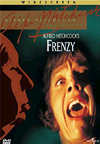Frenzy
Universal Home Video
Cast: Jon Finch, Barry Foster
Extras: ’The Story of Frenzy’ Documentary, Still Gallery, Production Notes, Cast & Crew Biographies, Theatrical Trailer
Rating:
"Frenzy" stars Jon Finch as Richard Blaney, a retired Air Force pilot who is a bit down on his luck. He’s just been fired from his job at a pub, which also happened to be his residence. Due to the dismissal from his job, Blaney won’t be able to spend as much time with his co-worker and sweetheart Babs (Anna Massey). To make matters worse, Blaney is low on cash, and refuses to take a handout from his friend Bob Rusk (Barry Foster). After spending the night in a Salvation Army shelter, Blaney pays a visit to his ex-wife Brenda (Barbara Leigh-Hunt), whom he hasn’t seen in over a year. Brenda is nice enough to buy Blaney dinner and give him some cash. During all of these scenes, we witness Blaney becoming increasingly angry, unstable, and violent.
You see, London is in the grip of terror as a sexual predator known as the "Necktie Murderer" (due to his propensity to strangle women with neckwear). The unpredictable behaviors, which Blaney displays certainly make him a likely candidate to be the "Necktie Murderer". But is he?
The visuals in the film show that Hitchcock hadn’t lost any of his gift for true cinema. The sweeping shot of the River Thames, which opens the film, is very impressive. But, the coup de grace comes with a tracking shot which begins at the 1:04:47 mark and goes until the 1:06:10 point, in which we witness the killer take a woman into his flat. (The trickery used to perform this shot is revealed in the documentary on the DVD.) Hitchcock also demonstrates his mastery for orchestrating film, as there are some genuinely suspenseful moments in the film.
As noted earlier, "Frenzy" is part of the upcoming "Alfred Hitchcock Collection" from Universal Home Video. The DVD presents the film in an <$16x9,anamorphic> <$PS,widescreen>, and the image is <$PS,letterboxed> at 1.85:1. The film is very clear, and in surprisingly good shape considering its age. There are some noticeable defects on the source print, but these are mostly white or black spots — there are no scratches or cuts. The image displays only a subtle amount of grain. And while it looks like a modestly budgeted European film from the 1970s, this transfer of "Frenzy" offers a very nice color palette, displaying natural looking skin tones, and nicely balanced reds, greens, and blues. The framing appears to be accurate, and despite the amount of extras on the DVD, there are no overt problems created by compression.
While "Frenzy" isn’t officially one of Universal’s "Collector’s Editions", it does boast some nice extras. The crown jewel on this release is a 45-minute documentary entitled "The Story of ’Frenzy’". Hosted by DVD producer Laurent Bouzereau, "The Story of ’Frenzy’" offers recent interviews with cast members Barry Foster, Jon Finch, & Anna Massey, screenwriter Anthony Shaffer, filmmaker Peter Bogdanovich, and Pat Hitchcock O’Connell, Alfred Hitchcock’s daughter. Through these interviews, along with scenes from "Frenzy", we learn a great deal about the production of the film. The highlight of this documentary are the rare behind-the-scenes segments which show Hitchcock at work. Any Hitchcock fan is going to love "The Story of ’Frenzy’".
More secrets are revealed in the still gallery, which contains nearly 100 photographs from "Frenzy". The first 30 or so stills are explicit shots from the murder, but if you can get through those, you will find a treat. Following a card with a note from DVD producer Laurent Bouzereau, we are treated to stills from three deleted scenes. One of these scenes is apparently an epilogue, which is hinted at in the film, but never shown.
Also included on the DVD are production notes, and cast & crew profiles. By far the most delightful extra is the theatrical trailer for the film. Presented in full-frame, the trailer for "Frenzy" recalls the preview for "Psycho" as Hitchcock himself (whom we first see floating on the Thames), gives the audience a guided tour of some of the more important locations for the film. The trailer clearly didn’t receive the kind of restoration work that the film, but for being 30 years old, it looks just fine.







